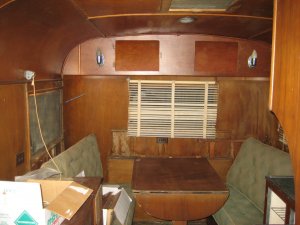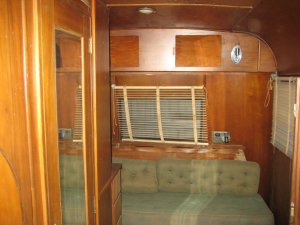- Home
- About Us
- Join/Renew
- Member Benefits
- Member Pages
- Log In
- Help
- Museum Store
Perfect answer, Paul!
Gene, I’m truly sorry you’ve had problems with THREE P-4259 pumps. You’re right, the “4269” is a typo and I should have caught it–my apologies.
Having to tap the pumps to get them going seems to be an indication of bad electrical connections, especially on three separate units, unless Carter’s (the manufacturer of my P-4259s sold by NAPA) quality control is very bad indeed. The P-4259 and other rotary vane pumps are not grounded through the bracket to the frame, as are the EP-11 pulse-style or diaphragm-style pumps, but use a separate grounding wire from a post on the pump. I drill a hole for the ground, remove paint around the hole, use a self-tapping metal screw–AND put a star washer under the screw to bite into the grounding surface.
I’ve had these P-4259 pumps on three cars for at least six and up to ten years with not a single issue.
The P-4259 instructions as to positive and negative leads are for negative ground cars, and our Pierces are positive ground. You may try reversing the connections.
Also note that the EP-11 pumps draw only about 4 amps, whereas the rotary vane pumps draw twice that, so a marginal ground on a rotary vane pump may be more troublesome.
Here’s why I no longer use EP-11 style pumps: One cannot tell from looking at the pump (or even the box–and it may have been re-boxed) whether the diaphragm material is designed with ethanol in mind. That is, when was the pump built or how fresh is it? On one of my “lesser cars”, a 1949 Willys Jeepster, an EP-11 would no longer pump fuel after 5,000 miles and 10 years. I removed the diaphragm cover and found that the diaphragm had turned to mush (the best term I can think of at the moment), and at the time I could find neither a source of replacement diaphragms nor any vendor who would guarantee that his new EP-11 contained a diaphragm that was resistant to ethanol. This information is three years old, so perhaps now EP-11s that are factory ethanol-resistant may be so marked.
I’d be interested in knowing of a vendor of ethanol-resistant diaphragms for EP-11 pumps, because I have three I haven’t thrown out yet!
Best wishes on getting a pump that’s reliable, and I’m sorry about your bad experience.
Best regards,
George
The “Type A” tail/stop/backup light assembly was used 1924 thru 1930, although some of the individual light bezels differ. As I recall, the screws are 4-40 (#4, 40 threads per inch), and the length required varies with the bezel. For most, about 5/8 to 3/4 inch length will work. The screws are slotted, oval head, countersunk.
I was able to find a small package of military surplus screws in stainless steel, which, after a couple of seconds on the buffer, look very good with either nickel or chrome bezels.
George
NAPA P-4269 (2-6 lbs) comes in a NAPA box but with a Carter sticker on the unit. It is likely not the shelf but they can have it for you in a day or two. Also, at $60-65 (last one purchased 2 yrs ago), that pump is about half the price I was quoted elsewhere.
You can try it without a pressure regulator, and if your carb floods, use a Holley #12-804 regulator which is far superior to the cheap detent models made overseas under the Purolator name. The Holley regulator can be found at performance auto parts stores.
Re Jerry Washburn: He is indeed the best, but he cannot take on any new business for awhile, as he is undergoing a second round of chemotherapy for cancer. Some of you have called me about your parts in his possession. I’ve seen them well-organized with your names and contact information on the open box flaps, but don’t have any further info for you at this time. Please keep Jerry in thoughts and prayers.
George
I forgot an important piece of information, the price: “Asking $33,000”
Tim,
Welcome to the PAS! I’ll send you a detailed email tonight with more info on Travelodges. For now, the highest known serial numbers reflect at least 149 Model A’s, 261 Model B’s, and 100 Model C’s produced. For some reason we can only speculate on, the Company used and I (eye) rather than a 1 (one) on at least the first digit on the serial number plate. A **working** discussion would call your serial 10225, but California DMV thinks my serial is II49 (eye-eye-four-nine), because that’s how it was stamped at the factory.
In the meantime, here’s an interior photo of Steve Babinsky’s highly original (“barn find” is so over-used!) Model B at Pebble Beach in 2010.
I’ll send you more photos and other info later.
Best regards,
George
I intended to mention (but failed to do so) that a great benefit of Halon is that it creates virtually no mess, unlike other extinguishing agents.
I concur completely with Greg (I had 27 yrs in the aviation industry) as to the desirability of Halon, but it is banned for new sales except for aviation use. The following is a quote from Wikipedia pertaining to USA requirements:
“Halon (including Halon 1211 and Halon 1301), a gaseous agent that inhibits the chemical reaction of the fire. Classes B:C for lower weight fire extinguishers (2.3 kg; under 9 lbs) and A:B:C for heavier weights (4.1–7.7 kg; 9–17 lbs). Banned from new production, except for military use, as of January 1, 1994 as its properties contribute to ozone depletion and long atmospheric lifetime, usually 400 years. Halon was completely banned in Europe resulting in stockpiles being sent to the United States for reuse. Although production has been banned, the reuse is still permitted. Halon 1301 and 1211 are being replaced with new halocarbon agents which have no ozone depletion properties and low atmospheric lifetimes, but are less effective. Currently Halotron I, Halotron II, FE-36 Cleanguard and FM-200 are meant to be replacements with significantly reduced ozone depletion potential.”
I have and carry with me in my Pierces two 10ABC Halon extinguishers that are still holding pressure.
Grainger sells Halotron extinguishers. I do not know the relative effectiveness of Halotron (there was also a “Halonite”) vs. the genuine Halon.
Can someone more knowledgeable direct us to other sources?
From early 1925 through early 1926 Series 80 cars were factory-equipped with Elgin (and perhaps other makes) speedometers and clocks while the Waltham workers were on a long strike. I can’t speak for the Series 33–was that the same experience?
Tony, that’s a good point. Let me try to clarify.
What Chris posted as sourced from Peter Williams and myself was written as info for Series 80/81 ONLY, although some of the info holds true for later cars.
I do recommend using 600W in NON-synchromesh transmissions.
For synchromesh transmissions and overdrives/free wheeling, I use 90 or 140 (depending on your climate and how worn your tranny is) that is GL-1 (i.e.,straight mineral oil without hypoid additives). In California, NAPA can get GL-1 oils within a day but those oils are not on the shelf–they do stock GL-4 and GL-5. Paul Johnson has posted good information on the desirability of GL-1, and the adverse effects of GL-5 (especially) and GL-4 in the past year or so.
For 1929 and later steering boxes, I prefer GL-1 gear oil of a weight your steering box will hold, 90 if possible, heavier if necessary. For very leaky boxes, you may need to use the 800W or 1200W Penrite lubricants from restoration Supply.
Re Tony’s issue: True, access to the steering box filler on 1936-38 cars is only by way of a fill tube. I don’t know whether the grease fitting he cites is authentic–my 1936 had a hinged-top oil cup at the fill end of that tube. I use a small pump-handle oil can filled with 90W gear oil to fill that tube. I agree that ANY kind of pressure filling of steering boxes is undesirable.
One of the sources of confusion is, I believe, that in the 1920s 600W, a heavy gear oil, was frequently referred to as “liquid grease.” Indeed, that was the chassis grease dispensed by the “compressor, grease” to suspension fittings.
Final photo:

Additional photo:

Bob, thanks for posting this. I think we are all grieving with, and praying for, Jim and Dot.
The hearse looks like a Series 80 chassis (full hood louvers) despite the (necessary) sidemount; the tire diameter appears large, probably 22-inch, which would make it a 1925 model.
The sedan appears to be a 1930 Model B Club Sedan.
George
Pierce never produced “shop manuals””as such. 1929 is the last year for which the “”owners manual”” (actually called “”Operation and Care”” manual or some variant) had “”how-to”” information on adjustments and repairs. So in my 1930 I carry a photocopy of a 1929 manual (the cars are mechanically very similar) for the technical information. 1930 and later OMs are essentially “”how to drive”” manuals.”
Mika,
It was our pleasure! We are delighted that you could free up a day to visit with us and talk Pierce-Arrows during your hectic vacation schedule. We’ll be happy to see you all again any time.
George
Congratulations, Roger–although it’s no surprise to us! You have done wonders with The Arrow!
Eddie,
I just emailed you the spreadsheet. Good luck and please keep us all posted!
George
A postscript to my last:
I’ll be happy to send the Excel spreadsheet on P-A (only) Timkens numbers from that 1934 catalog to any member requesting it. Chris, yours is on the way. 
George
